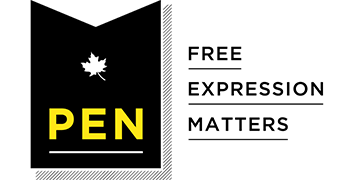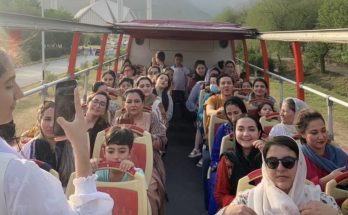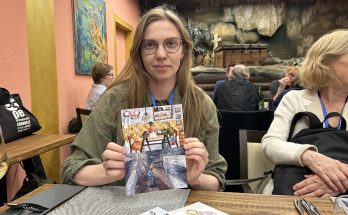Image: People hold hands in a large circle as drummers perform on stage at event at LeBreton Flats on National Day for Truth and Reconciliation Day in Ottawa, Canada on September 30, 2022. Photo Credit: Paul McKinnon, iStock ID 1430343205
Written by Jean Teillet
September 30, 2023, will mark the second anniversary of the National Day for Truth and Reconciliation in Canada. It is a day to remember the Indigenous children who attended residential schools. The day also coincides with Orange Shirt Day which commemorates the story of Phyllis Webstad, whose mother bought her an orange shirt to wear on her first day of school at the St. Joseph Mission Residential School. The shirt was taken from Phyllis that day and she never saw it again. Orange shirts are now a symbol of all the losses suffered by Indigenous peoples, the legacy of residential schools.
The purpose of residential schools was assimilation — to remove the “Indian” from the child. The Truth and Reconciliation Commission called the intention and the effect of residential schools “cultural genocide”. Children were removed from their homes and villages, taken to schools far away, separated from their siblings, and forbidden to speak Indigenous languages. Many children spent years in these schools and were never allowed to return home. Children who died at the schools were buried there, some in unmarked graves. Many parents never learned what happened to their children after they were taken away. The ones who eventually went home found themselves unable to speak to their families. Often returning youth would not even recognize their parents or other members of their families.
Here are some facts about residential schools in Canada.
- Over 130 residential schools operated between 1831 and 1996
- Approximately 150,000 children attended these schools
- An estimated 6,000 children died of malnutrition, tuberculosis, influenza, smallpox, measles, typhoid, diphtheria, pneumonia, and whooping cough, while attending residential schools
- Many children were psychologically, physically, and sexually abused
- The schools ran on child labour and, until the 1950s, students spent half the day in the classroom and half the day working
The legacy of residential schools is profound. The system crushed Indigenous cultures, broke families, and left generations of Indigenous peoples to be raised in brutal institutions and suffer the consequences for the rest of their lives. These children never knew love, were never held, or kissed or cuddled. No one nurtured them. They were wretchedly housed, starved, beaten, and abused. They were then tossed into society with a poor education, no skills, separated from their cultures and communities and left to fend for themselves. The long-term impacts remain with us today.
Canadians lost too. We lost beautiful thriving Indigenous cultures, we lost languages, art, laws, and governance and knowledge systems. Residential schools drove Indigenous peoples away from western knowledge and the entire education system. Generations of Indigenous peoples came to abhor the very idea of school. And with this came a loss of voice. We lost generations of Indigenous writers.
There are many ways to censor people. Societies can ban books, rewrite history, teach selectively or publish only the voices that reflect the majority viewpoint. With residential schools, Canada censored Indigenous languages, histories, and cultures. For more than a century Canada deliberately silenced Indigenous art, dance, stories and other forms of expression. That silence closed Canadian eyes and ears to even the possibility that they might learn from or enjoy Indigenous stories and history. Indigenous peoples lost virtually everything, but Canada lost too.
Canada today is a poorer country because we are ignorant of Indigenous history and stories. Canadians may know the names of some of the Indigenous peoples who live in this country, but most know nothing of their histories. In 2019, HarperCollins gave me the opportunity to write The North-West is our Mother, a popular history of the Métis Nation. I was fortunate to have such an opportunity. But it does make me ask when the popular histories of the Mohawk, the Haida, the Cree, the Tlicho and other Indigenous peoples will be published? The legacy of residential schools continues as long as Canadians, and especially our schools, remain unable to access the histories of Indigenous peoples.
Indigenous peoples are slowly recovering their languages and cultures, their stories, and histories. The horrors of residential schools are fading with every passing generation. But the legacy of silence is still very real, still a form of censorship. Because it is a choice when we don’t listen, when we don’t provide Indigenous writers with access to publishers, when we choose not to teach or learn about Indigenous peoples and their histories.
So, what is reconciliation in this context?
For most people, reconciliation has been a series of shocks. The publication of the Truth and Reconciliation Report in 2015 exposed residential schools to most Canadians for the first time. I have lost count of how many Canadians told me they had no idea, never learned about residential schools, and knew nothing of what happened there. The second big shock, in May of 2021, was the discovery of unmarked graves at Tk’emlúps te Secwépemc First Nation. To highlight just how disturbing this is, I ask two questions of Canadians – (1) Did your school have a graveyard? And (2) if a child died at your school, would their body not be returned to the family? Their answers usually help people understand the truth part of Truth and Reconciliation.
The discovery of the unmarked graves also proved that while Canadians learned, in 2015, about the existence of residential schools, most of them, including teachers and politicians, had not actually read the Truth and Reconciliation Report. If they had read it, they would have known about the unmarked graves because that report included an entire volume on the subject. Canadians are being shocked into learning their own history, and shocked by the fact that some of that history does not reflect their “nice” reputation. There will be more shocks to come.
Shock as the method of education aside, Canadians are learning and that is reconciliation. We have moved far from the mindset of intentional assimilation that created residential schools. That’s a good thing that should be recognized. Recognize too that reconciliation will take a long time. Canada dug itself into this hole over the course of two hundred years. We won’t dig ourselves out quickly.
Reconciliation is also not the process of shaming Canadians about what their ancestors did. Reconciliation means that Canadians learn from the past, form a sincere desire to change going forward, act on that desire and try to do better in the future.
So, as I reflect on the National Day for Truth and Reconciliation in Canada and Orange Shirt Day, I will dig my orange shirt out of my closet. I will wear it and I will remember.
Jean Teillet is an author, lawyer, treaty negotiator, women’s rights and Indigenous rights advocate, and PEN Canada board member.




